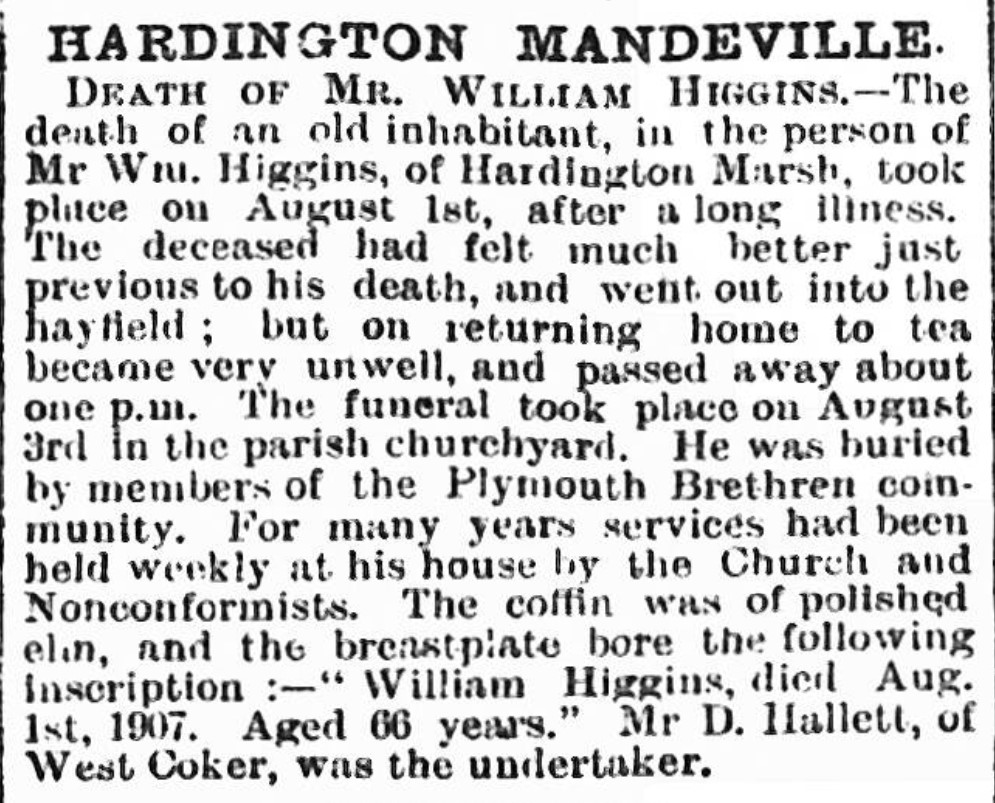Introduction
William Higgins served as a railway platelayer from the 1870s until his death in 1907. He was deeply religious and used his home in one of the railway cottages to host religious meetings, including gatherings for the Plymouth Brethren. He may have become more religiously active after the loss of his twelve-year-old son to meningitis. In his later years, William suffered from chronic bronchitis. His widow outlived him by eleven years, spending her final years in Haselbury.
Childhood
William was born at Hardington in about 1841, the seventh of nine children born to William and Hannah Higgins. His father, William, worked as a farm labourer.
When William was about fourteen, his sister, Hester, emigrated to Australia with her husband, Thomas England.
When William was sixteen, his father developed stomach cancer and passed away on 15 December 1857 at the age of 66.[1] His burial took place on Christmas Day, which was also the day his prospective son-in-law, James Withey, registered his death.[2]
William’s death left Hannah in sole charge of William and his younger siblings, Emma and George.[3] At some point in the 1860s, George enlisted in the Royal Horse Artillery.
Occupations
Until the 1870s, William worked as a farm labourer, like his father. By September 1877, he had become a railway platelayer.[4]
Marriage
In 1865, William married Susan Baker, the daughter of George and Anne Baker. At the time, William was about 24 years old, and Susan was about 27.
Like William, Susan had lost her father at a young age when he died of chronic bronchitis on 10 February 1849.[5] By April 1861, she was working as a house servant on a farm at Shipton Gorge. She had a brother, Henry Baker, who was a railway platelayer in April 1871.
Residence
By April 1881, William and Susan lived in one of the railway cottages at Hardington Marsh.
Children
William and Susan had a son, William George, born in 1865, followed by twin sons, Joseph and George, born in September 1866. Joseph died after eight days, and George died after nine days. They were buried just two days apart.
On about 10 September 1877, William George fell ill with meningitis and died fourteen days later at the age of twelve.[6]
Religious faith
The pain of losing all three of their children may have drawn William and Susan closer to religion. Their home became a venue for both Church and Nonconformist services, and they appear to have become members of the Plymouth Brethren.[7]
Death
William suffered from bronchitis for many years. On Wednesday, 31 July 1907, he felt better and completed some work in a hayfield. However, upon returning home for lunch, he became very unwell and passed away at about 1 p.m. at the age of 66.
Three days later, he was laid to rest in the village churchyard, and members of the Plymouth Brethren community conducted his funeral.[8]
After William’s death, his belongings were auctioned by William Redwood. The sale included an oak carved chest and sixty head of poultry.[9]
After William’s death, Susan moved to Haselbury, where, in April 1911, she lived in a two-room residence in North Street. She died in the Yeovil district in 1918 at the age of 79.
References
[1] Death certificate of William Higgins.
[2] James Withey married Elizabeth Higgins at East Coker on 5 August 1860.
[3] Two daughters, Jane and Elizabeth, may also have been living at home, but they were in their twenties.
[4] Death certificate of William George Higgins.
[5] Death certificate of George Baker.
[6] Death certificate of William George Higgins.
[7] Western Chronicle, 9 August 1907, p.6.
[8] Western Chronicle, 9 August 1907, p.6. According to this report, William died on 1 August 1907, which was the date inscribed on the breastplate of his coffin. However, according to his death certificate, he died on 31 July, and his niece, Emma Eastment, registered his death the same day.
[9] Western Gazette, 20 September 1907, p.2.






